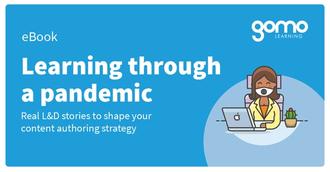eLearning during a pandemic: Real L&D stories from a lead learning designer
- Given the disruption of the pandemic period, how are learners feeling going forward—and how can L&D accommodate this when creating learning programs?
- What role can eLearning play when adapting to challenges brought on by the pandemic?
- What were the lessons learned and have you adapted your learning programs as a result?
- What aspects of face-to-face learning have you missed the most during the pandemic?
- Have you been able to overcome these challenges? If not, what would be your ideal solution?
- What are your favorite authoring tool features that help to engage your learners?
- What are the main challenges you face when creating eLearning for a global workforce?
- How does an authoring tool help you overcome these challenges?
The last 18+ months have seen learning professionals adapting everything from the way they author learning content to how they deliver training. With challenges like learner engagement and employee isolation in mind, L&D departments will continue updating their learning programs to enhance the all-important learner experience.
In this extract from our ebook, ‘Learning through a pandemic: Real L&D stories to shape your content authoring strategy’, we look at how the learning landscape has changed. The insights from this article were informed by a Q&A with Derek Phillips, a US-based Lead Learning Designer at our sister company, LEO Learning (learning strategy and design experts).
Global audiences have reacted to the pandemic—causing a seismic shift to remote working—with eLearning the go-to way of reaching global audiences. We were keen to find out what this meant for content authoring strategies going forward.
Plus, there’s more info on how you can tap into the trends we’re seeing now so that you can use them to inform your future eLearning programs.
Is microlearning on your content authoring to-do list? Don’t wait, read:
‘eLearning during a pandemic: Embracing the benefits of microlearning’Given the disruption of the pandemic period, how are learners feeling going forward—and how can L&D accommodate this when creating learning programs?
I would say learners are feeling restless and cautiously optimistic. We’ve passed the tipping point of returning to “business as usual”. Learners are accepting this fact. However, the “Zoom fatigue” caused blowback. This means customers and their learners are ready to explore new tools and platforms that are user-friendly, as well as time-and-cost effective.
What role can eLearning play when adapting to challenges brought on by the pandemic?
Based on the customers I work alongside, I noticed a divide. Several organizations’ learners were accustomed to working from home and interacting remotely but went full-time remote at the onset of the pandemic. Others, however, who work in labs or on production floors, needed to return to their work environment. Regardless of the environment, customers sought to minimize physical contact, and eLearning has played a role in that process.
Want a few ways to save time and money on your eLearning design? See our tips:
‘23 free eLearning resources loved by L&D teams’What were the lessons learned and have you adapted your learning programs as a result?
Prior to the pandemic, many organizations saw eLearning as auxiliary or as a “back-up plan” to in-person training opportunities. As a result of going remote, I see us (professionals in this industry) as coaching our more skeptical customers toward a new perspective. Learning programs have naturally evolved and become more robust as our customers begin to imagine new possibilities and allow us to become more creative in our learning solutions.
What aspects of face-to-face learning have you missed the most during the pandemic?
Although I’ve missed in-person rapport-building (on-site with customers), I notice that we have adapted and now have new ways of designing virtual focus groups, kick-offs, and even filming sessions. We’ve become more intentional, and seeing each other and our customers in home surroundings adds a sense of “humanity” to our daily interactions.
Have you been able to overcome these challenges? If not, what would be your ideal solution?
We incorporate more interactivity into our online sessions, as well as more breaks. Trying out new tools and new methods helps to keep customers’ interest, and often transparency is our greatest tool.
Read this customer story about how they used our eLearning authoring tool during the pandemic:
‘How an electronics corporation globalized, modernized , and simplified eLearning production’What are your favorite authoring tool features that help to engage your learners?
More and more customers are embracing social learning. Gomo, when leveraged alongside customer Learning Management Systems such as Docebo, can do great things when it comes to connecting learners and keeping conversations going.
What are the main challenges you face when creating eLearning for a global workforce?
I would say hesitation to adapt. However, as already mentioned, the pandemic has forced more skeptical customers’ hands to embrace eLearning out of necessity. Even in more hands-on industries (automotive, for example), organizations are beginning to see the benefits of eLearning strategies such as AR and VR.
How does an authoring tool help you overcome these challenges?
Many of our customers have expressed a desire to create a “one-stop-shop” UX, and Gomo is optimal for this request. Features such as its inherent mobile-friendliness, as well as its Resources and Glossary topics, encourage learners to revisit key learning assets, even on the go or long after they’ve finished a course.
About the author: Derek Phillips
Derek joined LEO Learning in July 2018 and, as Lead Learning Designer is responsible for scoping clients' projects and bringing them to life. He strives to create dynamic learning solutions that are meaningful and relevant to adult learners.

